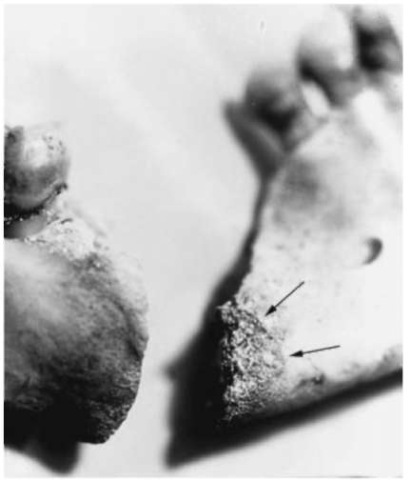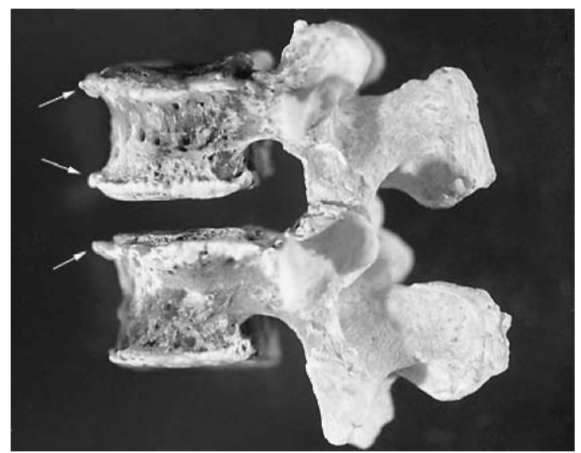Introduction
Because they are so durable, bones and teeth are often pivotal to the solution of human remains cases. The skin, flesh, organs and body fluids (the domain of forensic pathologists) that provide such a wealth of data for identification and the interpretation of events that surround death, normally disappear after a few months or weeks. But the skeleton may endure, often intact, for centuries. Of course, in events like fires, remains may become skeletonized within minutes. What can be learned from a skeletonP How can skeletal remains contribute to forensic science?
Forensic anthropologists are specialists in human skeletal biology who apply their skills to medicolegal cases. Typically, forensic anthropologists have obtained an advanced degree (Masters or PhD) in physical anthropology with a specialization in skeletal biology and training in the legal applications of their skills. In North America most forensic anthropologists are members of the Physical Anthropology Section of the American Academy of Forensic Sciences. About 50 North American forensic anthropologists have been certified by (and are Diplomates of) the America Board of Forensic Anthropology. Board Certification requires a PhD in Physical Anthropology (human osteology specialization), a minimum of 3 years of practical experience, and the successful completion of written and practical exams.
Currently, most forensic anthropologists are employed by universities, however, some work for local, state or federal government agencies. The United States Central Identification Laboratory in Hawaii (CILHI), for example, has a staff that includes more than 20 full-time forensic anthropologists. The CILHI anthropologists help carry out the mission of identifying the remains of Americans found on foreign soil. A few forensic anthropologists assist the United Nations and the organization, Physicians for Human Rights, with the identification of suspected victims of political activity in places like Latin America, the former Yugoslavia and Central Africa.
Investigators who bring remains to forensic anthropologists usually want one or several of the following questions answered: Are these remains humanPAre they recent enough in origin to be of medicolegal interestP Who do the remains representPIs there evidence for cause or manner of deathPThis article illustrates the most important kinds of information that can be gained from studying the skeleton and illustrate how such information can contribute to forensic science.
Identification
Are the remains human?
Forensic anthropologists are experts in the morphology (form) of the human skeleton. Many suspected human cases are decided in the few minutes that it takes the anthropologist to recognize that a single bone or bone fragment does not come from a human skeleton. The ability to quickly and confidently make such a judgment results from years of intensive study of the form and function of human bone. Most forensic anthropologists have studied human gross anatomy, usually in a medical school, and all have spent years poring over minute details of the skeleton. The anthropologist may not always be able to identify the species from a fragment of bone, but in most cases, he or she can determine rather quickly if it is human.
Because of their skeletal structure, some species are more difficult than others to distinguish from human remains. In North America, for example, bear bones can be particularly vexing (Fig. 1). For people without specialized training or experience it can be very difficult to distinguish between the bones of many mammals and even birds and those that are human.
On occasion, bone fragments are so small that species identification by gross morphology is not possible. In some of these cases, a microscope may be helpful. Because of the way in which the mineral component of bone (mainly calcium and phosphate) is deposited and later remodeled, the microscopic structure or (histomorphology) of bone is unique. And, since the bone of different species is deposited in different patterns it is usually possible to identify human bone fragments from microscopic sections. Figure 2 is a comparison of a cross-section of human bone and one from a cow. Note that the human bone displays a number of circular structures, known as Haversian systems, distributed among a backdrop of parallel layers. Haversian systems result from the remodeling of parallel layers that are generally concentric to the cross-section of bone. The rectangular (plexi form) pattern displayed by the cow section is generally characteristic of herbivores. There are a few species where confusion with humans may arise, large dogs or wolves, for example, but to an experienced bone histomorphologist, human bone is unique.
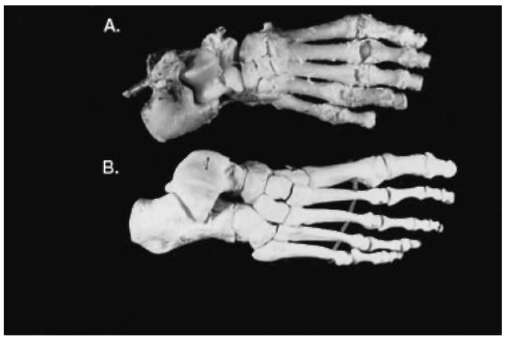
Figure 1 (A) Bear foot (B) human foot. The human foot is a right foot; the bear foot is a left foot. Both are viewed from above.

Figure 2 Microscopic sections of (A) cow and (B) human cortical bone. The arrows indicate Haversian systems in the human bone.
Are the remains recent?
Estimating the time since death is one of the most difficult tasks of the forensic anthropologist. When a fresh human body is deposited in the environment, a series of regular and relatively rapid changes begin to occur. If the remains are discovered within a few months, it is often possible to estimate the postmortem interval to within a few weeks. In such cases input from a forensic entomologist, who may analyze insects associated with the corpse, may be very helpful. After the soft tissue has decomposed and only the skeleton remains, however, the decompositional process slows down. The bones lose their moisture content and the fatty marrow begins to leach out of the medulary cavity (hollow space inside the bone). The bones become lighter, lose the smell of fat and decomposing organic matter and usually begin to take up stain from the surroundings or soil. After a few years it may be very difficult to distinguish between bone that is generally too old to be of forensic interest (50 years or more) and the remains of a more recently deceased individual that might be identified.
The context of the remains may provide key information for the determination of time since death. Evidence of past burial practices, including ancient artifacts, like stone or early metal tools, may signal a particular cultural horizon and therefore indicate time of death. Even coffin handles or coffin nails may help date remains. Because the direct association between such associated items and human remains must be firmly established, a thorough understanding of the conditions of discovery is essential. Forensic anthropologists often work closely with archaeologists, or may have experience in archaeological techniques themselves. Archaeological methods of recovery have proved invaluable for the collection of decomposed human remains and for understanding their context.
Who is it?
If it can be established that the remains are human and are recent enough in origin to be of medicolegal interest, then identification is likely to be attempted. Identification normally begins with the construction of a biological profile, the primary elements of which are: age, sex, race and height. In some cases evidence for medical history (such as a healed bone fracture), may provide clues to identity. With a biological profile, authorities are able to begin scanning their missing person reports and hopefully provide one or a few candidates for positive identification. If such a profile does not yield a positive identification, a facial approximation (from the skull) may be carried out.
Estimation of age Estimating age at death can be extremely difficult, especially as people mature. Although it may be possible to estimate the age of a child or infant to within a few months, the age ranges for adults may be 20 years or more. Because different methods are used to estimate the age of infants and children, young adults and older adults, the methods for each are discussed separately.
Infants and children (fetal to about 15 years) The best methods for estimating fetal age and that of young children involve dental development. Deciduous (baby) teeth begin to calcify early in the fetal period and continue developing until the third year, at which time the development of the permanent dentition is well underway. By comparing to established norms, the stage of formation of each available tooth and the eruption of teeth to the chewing surface, biological age can be estimated to within several months or a couple of years (Fig. 3). Because dental enamel is the hardest substance in the human body and, therefore, most likely to be preserved, dental development is particularly useful for forensic cases.
Less accurate than dental development, but also important for estimating skeletal age is bone growth and development. In cases involving fetal remains and those of young children, it is often possible to estimate age by comparing the length of long bones (like the femur or tibia) to published charts. Because rates of growth vary in different groups, it is important to use data collected from a population that is most representative of the remains in question.
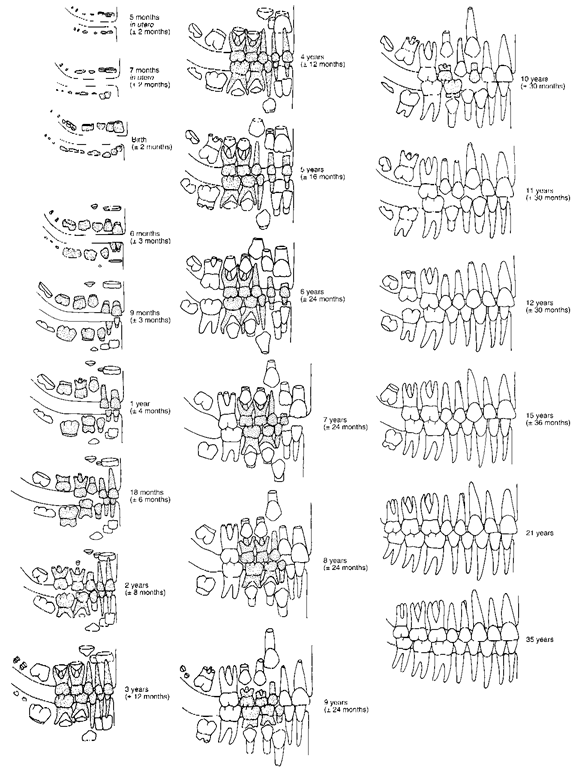
Figure 3 The sequence of formation and eruption of teeth among American Indians
Finally, the appearance and union of growth centers can be useful tools for subadult age estimation. Most bones do not grow as single units, but as primary and secondary centers of growth or ossification. The primary center is the first to develop, the shaft of the femur, for example, at around the eighth-week of fetal life, and the secondary centers at either end (epiphyses) appear much later in fetal development or after birth. Bones with multiple centers of ossification cease to grow when the primary and secondary centers of ossification fuse together. Because the various epiphyses of different bones appear and fuse at different times, the study of growth centers is a valuable tool for estimating the age of children and young adults. Most useful for estimating the age of older children and young adults are the femur, the shoulder, the clavicle and portions of the hip bone.
Young adults (15 to about 35 years) Epiphyseal union continues to be an important age indicator in young adults. The last epiphysis to completely fuse is the medial end of the clavicle, usually at between 25 and 30 years of age.
Beginning in the later teenage years, a number of systematic changes have been recognized to occur on several joint surfaces. Probably the best known is the metamorphosis of the pubic symphysis (the joint between the two pubic bones of the pelvis). Initially the surface of the joint is characterized by a series of deep horizontal furrows and the joint flares anteriorly. During the twenties the furrows fill in and the build-up of bone causes the opposing bone surfaces to flatten. Usually during the thirties, a recognizable rim forms around the margin of the joint. The transformation of the pubic joint surfaces begins at about 18-20 years of age and continues throughout life (Fig. 4). Age can be estimated by comparing the pubic joint surface to available descriptions, illustrations and casts. For a variety of reasons, including the involvement of the pubic joint in childbirth, pubic symphysis aging is most reliable in males and, for both sexes, the reliability of pubic symphysis declines dramatically after about 35 years of age.
Regular changes have also been recognized for the sternal (chest) end of ribs. In the 1980s, Susan Loth and Yasar Iscan began to collect and analyze the sternal ends of fourth ribs from a large sample of individuals of known age and sex. They described for males and females, how the sternal extremity of the rib changes from a flat, billowed surface to first a ‘V shaped then a ‘U’ shaped pit. As the pit deepens, its surface becomes pitted and the margins become increasingly irregular. As is the case for the pubic symphysis, photographs accompany the description of the changes in the sternal extremity of the fourth rib. Also, like the pubic symphysis, the rib ends become increasingly unreliable after the third or fourth decade. An advantage of both these methods is that they involve bones that are close to the surface and can easily be removed during autopsy.
Older adults (over 35 years of age) Beginning during the fifth or sixth decades of life, a number of ‘degenerative’ changes may be identifiable on the skeleton. Joint surfaces often begin to show progressive changes associated with arthritis. Tiny spicules of bone may appear on the margins of the vertebral bodies (osteophytosis) (Fig. 5) and some lipping may appear around the edges of moveable joints like the knee and elbow or hands and feet. The pubic symphysis and rib ends also show signs of advancing age.
As individuals mature, the dentition and supporting bone also display characteristic changes. The chewing surfaces of teeth slowly wear, the effects of dental disease accumulate, and the bone of the maxilla and mandible tends to resorb. Older people are also more likely to be missing certain teeth.
Aging by histomorphology It was mentioned above that the microscopic structure of bone is useful for distinguishing between human and nonhuman bone. Because of changes in microstructure that occur during an individual’s life (for example, Haversian system accumulate), it is also possible to estimate the age at death of an individual by studying sections of bone under a microscope.
Determining sex Because most sexual dimorphism (differences in shape between males and females) develop during puberty, most forensic anthropologists agree that the determination of sex from the skeleton is only practical for late teenagers or adults. Generally, male skeletons are larger and more robust than female skeletons. By studying features of the skull and especially the hip bones, experienced osteologists should be able to identify sex with a better than 95% degree of accuracy.
Innominates (hip bones) Three features on the pubic region of the innominates are particularly useful indicators of sex; the ventral arc, the subpubic concavity and the shape of the ischiopubic ramus (Fig. 6). The ventral arc is a curved ridge of bone on the anterior surface of the pubic bone just lateral to the pubic joint. It is a common feature in females and almost never seen in males. Viewed from the front, the medial edge of the bone that extends laterally and inferiorly from the joint between the pubic bones is often concave in females and straight or convex in males. And finally, the medial (inner) edge of the bone connecting the pubic bone and the ischium is normally wide and flat in males and a narrow ridge in females. If a pubic region displays a ventral arc, subpubic concavity and narrow ischiopubic ramus, the specimen is very likely to be female. Another sign that a hip bone is from a female is a wide subpubic angle (Fig. 6).
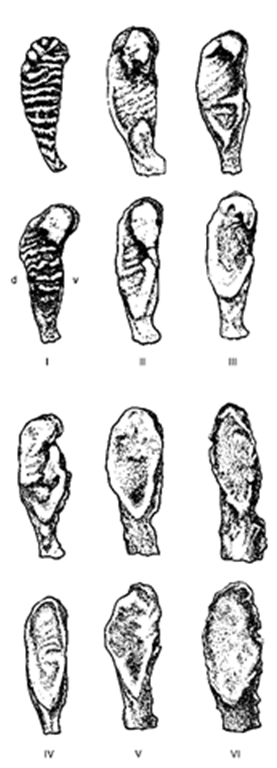
Figure 4 Suchey-Brooks pubic symphyseal phases (I—VI). V, ventral side. Redrawn from Burch and Suchey, 1986
Figure 5 Two lumbar vertebrae of a 60-year-old male. Arrows indicate osteophytosis.
Figure 6 Female (A) and male (B) pubic bones. VA, ventral arc; SPC, subpubic concavity; SPA, subpubic angle.
The skull Sexually dimorphic features of the skull include the brow ridges, the mastoid processes, and the external occipital protuberance, all of which are usually more pronounced or larger in males (Fig. 7). The chin portion of the mandible tends to be squarer in males and more rounded (or ‘V shaped) in females.
Ancestry and race The estimation of one’s ancestry is complicated by the fact that most anthropologists agree that dividing the World’s human populations into three or four broad races is unscientific and not warranted on biological grounds alone. Nonetheless, the popular notion that there are three or four races of humankind permeates much of our thinking and is the framework usually used by the law enforcement community to identify missing persons and suspects. Therefore, it is usually useful to include in a biological profile, a prediction about the racial identity of a set of unidentified human remains. This is usually accomplished by identifying the broad geographic region of one’s ancestry and translating that into terms that are used in the community. In the US, remains that suggest European ancestry are likely to be labeled ‘White’.
To estimate ancestry, investigators usually evaluate features of the skull like the shape of the eye orbits, the nasal opening, and the zygomatic or cheek bones. Some anthropologists find the root of the nasal bones in the area between the eye sockets particularly useful. Skull shape may also be evaluated by taking a series of measurements. A computer program may then be used to evaluate ancestry by comparing cranial dimensions of an unidentified specimen to those from a large sample of crania of known ancestry.
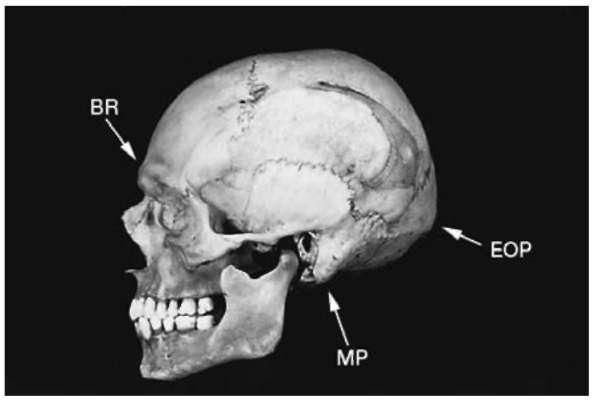
Figure 7 Male cranium. BR, brow ridge; MP,mastoid process; EOP, external occipital protuberance.
Stature Anthropologists usually use one of two methods to estimate living height from the skeleton: the anatomical method or limb bone proportionality. The anatomical method involves measuring all of the skeletal elements that contribute to height and then adding a constant. To use the method, the investigator measures the distance from the top of the skull to the foramen magnum, where the skull joins the uppermost vertebra; the height of all of the cervical, thoracic and lumbar vertebral bodies; the femurs; the tibiae; and the talus and calcaneus of the foot. A constant of 10-12 cm is then added to account for soft tissue and other distances that are not taken into account by the measurements.
The limb bone proportionality method relies on well-studied relationships between the length of limb bones and living height. The formulas used most often today are equations that were originally developed in the 1950s on documented anatomical collections and victims of World War II and the Korean War. Because of the variation in long bone-to-height ratios among the world’s populations, different formulas are provided for different groups. Probably because of ease of use and the fact that the skeleton need not be so complete, forensic anthropologists rely more heavily on the limb bone proportionality method for estimating living stature from the skeleton.
Secondary features (SES, medical history, markers of habitual activity) In addition to the four customary categories of most biological profiles (age, sex, ancestry/race and height) forensic anthropologists may also contribute information about socioeconomic status, medical history and evidence for habitual activity. Although such generalizations must be approached with caution, it is sometimes possible to estimate that a person is from a lower or higher socioeconomic level because of the location of the remains and associated items like clothing or jewelry. Evidence for certain dental procedures or lack thereof may also indicate access to particular types of treatment. A skeleton that presents advanced untreated dental caries (cavities) or evidence for particularly severe and chronic gum disease may signal that a person is from a low socioeconomic status.
Certain aspects of medical history may also be useful for identification. For example, the presence of an artificial limb or joint may help match an unidentified skeleton with a missing person. In one recent case in our lab, an unidentified skeleton was diagnosed with a rare metabolic disease, acromegaly, which dramatically affects the growth of bone. If a missing person were described as suffering from acromegaly, then the recognition of the disease on the skeleton might have been very useful for identification.
Throughout an individual’s life, the bones of the skeleton continue to remodel and reshape themselves according to stresses that are placed upon them. This is known as Wolff’s law. By studying the robustness of selected bones and the nature of certain muscle attachments it is sometimes possible to draw conclusions about a person’s activities during life. A person who spent most of their life as a stone mason, lugging around cement blocks, is likely to have a very different looking skeleton than a typical anthropology professor.
Facial approximation A useful addition to the biological profile (age, sex, height, ancestry, etc.) is often a facial approximation. Traditionally, facial approximations entail placing tissue depth markers at a number of specified points on and around the facial skeleton, then connecting these markers with clay. Nose, lips and ears are formed using certain skull and tooth dimensions as guidelines. Prosthetic eyes are carefully positioned in the eye sockets before the surrounding eyelids are shaped. The final product (Fig. 8) is an image that can be distributed to regional law enforcement agencies and displayed on television and in the newspapers. It is hoped that someone will recognize the face and contact the authorities.
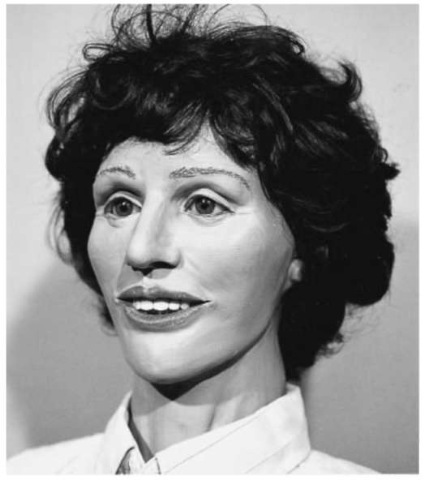
Figure 8 Facial approximation from the skull of a female believed to have been 30-50 years of age at the time of death.
In recent years, facial approximations are increasingly being carried out with the aid of computers. An image of the skull is displayed on the screen and the soft tissues are added as appropriate for the biological profile. Some experts prefer to sketch soft tissue features over an image of a skull, then scan images of both the skull and drawing onto a computer screen for final adjustment. Computer assisted approximations are not only quicker to carry out than clay reconstruction, they are also easier to modify after the process is complete. There are no reliable studies that compare the accuracy or effectiveness of the various methods of facial approximation.
Positive identification Once a biological profile and possibly a facial approximation have been generated for a set of remains, they can be compared to lists and descriptions of missing persons. If there is a match in the general features, then an attempt is normally made at positive identification. Most commonly, positive identifications are made by comparing X-rays (usually dental) taken during a missing person’s life with X-rays taken from the same area of the unidentified skeleton. If, in the judgment of an expert with training and experience in the interpretation of X-rays, there is a match in a sufficient number of features, then the remains may be considered positively identified. Figure 9 is a comparison of the frontal sinuses of a missing male, and of a skeleton that was discovered in a nearby wooded locale. X-rays of parts of the skeleton other than the skull, such as limb joints and the vertebral column, are also useful for positive identification.
Sometimes, when there are no appropriate ante-mortem (before death) X-rays available for a missing person, it may be necessary to compare the shape of the skull and its features to a photograph taken during life. This process, known as skull-photo superimposi-tion, may, under certain circumstances, also yield a positive identification. Skull-photo superimposition, is performed more often in parts of the world, e.g. China and Japan, where antemortem X-rays are less common.
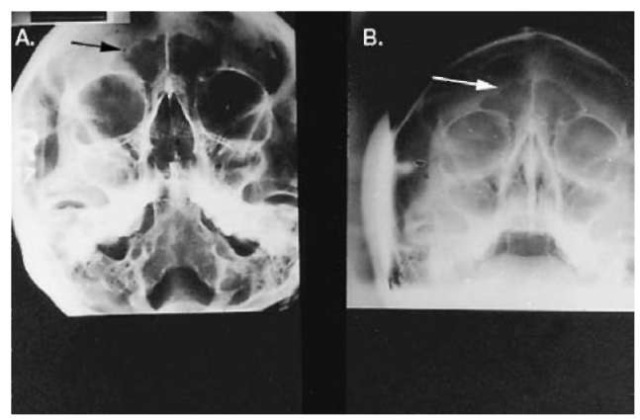
Figure 9 Comparison of postmortem (A) and antemortem (B) images of the frontal sinus of a male skull (arrows).
Manner and Cause of Death
In addition to identifying human remains, forensic anthropologists are often called upon to help interpret evidence for manner or cause of death.
Marks on the bones themselves can provide very important clues about how a death occurred. Bullets penetrating the skull, for example, typically create a characteristic defect (Fig. 10). From such damage, an expert may be able to make judgments about the maximum caliber of a gun and the angle and velocity of a projectile. Similarly, details of weapons may be indicated by blunt force damage (like that from a hammer) or various knife strikes. It has shown that it may even be possible to identify a specific knife using electron microscope images of skeletal damage.
With all evidence of skeletal trauma, it is imperative to recognize and distinguish among antemortem (before death), perimortem (around the time of death) and postmortem (after death) trauma. A skull fracture may indeed reflect a blow to the head that caused death. But before such a conclusion is drawn, it must be established that the damage is not evidence of an old injury, from which the victim survived, or that the damage occurred to the skull as it lay on the forest floor long after death. The hallmark of antemortem injuries, evidence for healing near the margins of the fractured bone, may appear as soon as two or three weeks after an injury (Fig. 11).
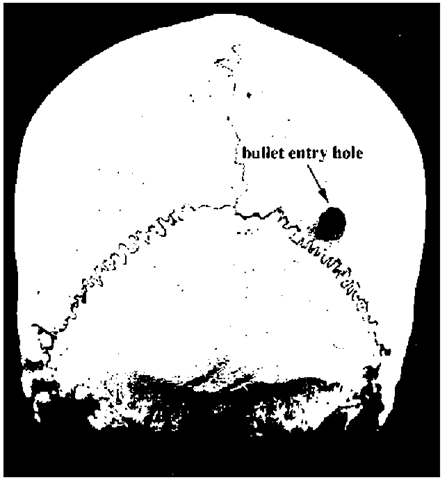
Figure 10 Bullet damage to the rear of a skull. The opening in the inside is much larger and reflects a cone-shaped defect.
Because dried bone has different fracture characteristics than bone from living organisms, it is sometimes possible to distinguish between perimortem and postmortem damage by studying details of skeletal lesions. Differential staining may also indicate postmortem damage. When bone lies in a soil environment for a period of years, the exposed surfaces typically become stained from ground water. When a fracture occurs at or near the time of discovery, a new unstained surface may be created that contrasts distinctly with the stained bone.
The context in which remains have been recovered can also provide important clues about how a person dies. The techniques of forensic archaeology may demonstrate that the orientation of a body (for example, with the hands bound behind the back) or the position of a potential murder weapon are clues that a homicide took place and that death was unlikely to have been accidental.
The Forensic Anthropology Laboratory
Although all forensic anthropologists are capable of generating a biological profile from a person’s skeletal remains and assisting with positive identification, some have specialized in specific areas like trauma analysis, facial approximation or microscopy. Similarly, forensic anthropology laboratories are variously equipped to provide different kinds of services. Presumably a forensic anthropology lab would minimally include adequate work surfaces for the examination of a set of skeletonized human remains, appropriate water sources and disposal facilities, a comparative skeletal collection and a full range of calipers. An ideally suited forensic anthropology lab might also include facilities for handling remains in all stages of decomposition; instrumentation for thin section preparation and microscopic analysis, including electron microscopy; image superimposition equipment; and instrumentation for DNA analysis. Although such labs and combinations of expertise are rare, cooperation among forensic anthropologists and other scientists usually allows for sufficiently complete anthropological evaluations of cases involving decomposed remains.
